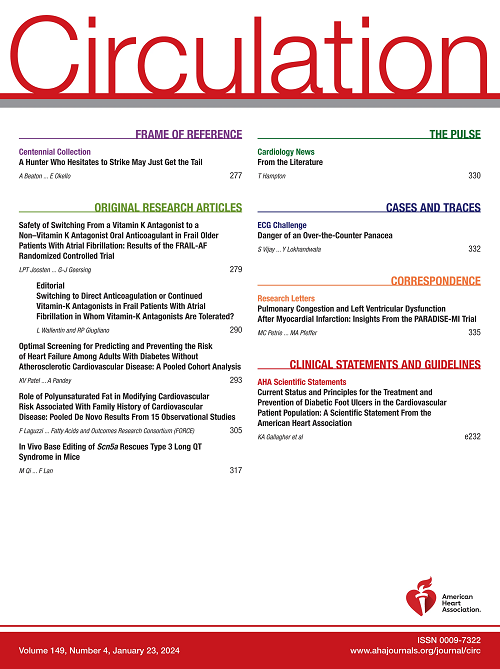Intensity, Duration, and Context Dependency of the Responses to Nutrient Surplus and Deprivation Signaling in the Heart: Insights Into the Complexities of Cardioprotection.
IF 38.6
1区 医学
Q1 CARDIAC & CARDIOVASCULAR SYSTEMS
引用次数: 0
Abstract
Nutrient surplus sensing through PI3K (phosphoinositide-3-kinase) and mTOR (mechanistic target of rapamycin) stimulates anabolism to expand cellular mass, whereas nutrient and energy deprivation sensing through SIRT1 (sirtuin-1) and AMPK (adenosine monophosphate-activated protein kinase) promotes catabolism to support cytoprotective quiescence. By signaling through downstream effectors (PGC-1α [peroxisome proliferator-activated receptor gamma coactivator 1-alpha], PPARα/PPARγ, FoxO1 [forkhead box protein family O1], NRF2 [nuclear factor erythroid-derived factor 2], HIF-1α [hypoxia-inducible factor-1α], and HO-1 [heme oxygenase-1]), environmental nutrients, growth factors, and cellular stress influence mitochondrial biogenesis, autophagic flux, cardiac hypertrophy, and cardiomyocyte senescence and apoptosis. Despite these canonical descriptions, the actual response to each effector is determined by the intensity and duration of signaling. Typically, transient and measured signaling produces adaptive effects, whereas continuous heightened activity yields maladaptive responses. The effects of signaling are also influenced by context; ie, the nature and intermittency of the external stress and the characteristics of the underlying substrate (eg, cardiomyopathy, obesity, or aging). PI3K signaling promotes physiological hypertrophy and is cardioprotective during abrupt cardiac stress, but its sustained activation accelerates pathological hypertrophy related to obesity and aging. Signaling through SIRT1/AMPK (and upregulation of autophagic flux) exerts favorable effects during exercise training and in chronic cardiomyopathy, obesity, and aging, but it undermines the cardiac response to abrupt stress. Intermittent FoxO1 upregulation may promote physiological hypertrophy while antagonizing pathological hypertrophy, but prolonged activation leads to cardiomyocyte apoptosis. NRF2 exerts antioxidant effects when background autophagic flux is vigorous but aggravates cellular stress when autophagy is suppressed (as in pathological hypertrophy). Sustained activation of PPARγ, NRF2, and HIF-1α in nutrient surplus states can lead to maladaptive ventricular remodeling, thus explaining the results of clinical trials with thiazolidinediones, bardoxolone, and prolyl hydroxylase inhibitors. The influence of duration, intensity, and context may be mediated (in part) by the activation or suppression of counterregulatory mechanisms, by the selective recruitment of corepressors, and by posttranslational protein modifications. These observations, considered collectively, suggest that no protein or cellular process viewed in isolation can be regarded as cardioprotective or maladaptive. Cell signals operate usefully if they are delivered as part of an orchestrated program of compartmentalized nuanced bursts, acting as elements of multifaceted oscillating systems whose periodicity is determined by the need to achieve homeostasis.心脏中营养过剩和剥夺信号反应的强度、持续时间和环境依赖性:对心脏保护复杂性的见解。
通过PI3K(磷酸肌苷-3激酶)和mTOR(雷帕霉素的机制靶点)的营养过剩感知刺激合成代谢以扩大细胞质量,而通过SIRT1 (sirtuin-1)和AMPK(单磷酸腺苷活化蛋白激酶)的营养和能量剥夺感知促进分解代谢以支持细胞保护性静止。通过下游效应物(PGC-1α[过氧化物酶体增殖物激活受体γ辅助激活因子1- α]、PPARα/PPARγ、FoxO1 [forkhead box蛋白家族O1]、NRF2[核因子红系衍生因子2]、HIF-1α[缺氧诱导因子1α]和HO-1[血红素加氧酶1])、环境营养素、生长因子和细胞应激等信号传导影响线粒体的生物发生、自噬通量、心肌肥大和心肌细胞衰老和凋亡。尽管有这些规范的描述,对每个效应的实际反应是由信号的强度和持续时间决定的。通常,短暂的和可测量的信号产生适应性效应,而持续增强的活动产生不适应反应。信号的作用也受到环境的影响;即,外部压力的性质和间歇性以及潜在底物的特征(如心肌病、肥胖或衰老)。PI3K信号促进生理性肥厚,在突发性心脏应激时具有心脏保护作用,但其持续激活会加速与肥胖和衰老相关的病理性肥厚。通过SIRT1/AMPK信号传导(以及自噬通量上调)在运动训练和慢性心肌病、肥胖和衰老中发挥有利作用,但它破坏了心脏对突然应激的反应。fox01的间歇性上调可能促进生理性肥厚,同时拮抗病理性肥厚,但长期激活会导致心肌细胞凋亡。当背景自噬通量旺盛时,NRF2发挥抗氧化作用,但当自噬受到抑制时(如病理性肥大),NRF2会加重细胞应激。在营养过剩状态下,PPARγ、NRF2和HIF-1α的持续激活可导致不适应的心室重构,从而解释了噻唑烷二酮类、巴多洛酮和脯氨酰羟化酶抑制剂的临床试验结果。持续时间、强度和环境的影响可能(部分地)通过激活或抑制反调控机制、选择性募集辅阻遏物和翻译后蛋白修饰来介导。综合考虑这些观察结果,表明单独观察的任何蛋白质或细胞过程都不能被视为心脏保护或适应性不良。如果细胞信号作为一个精心编排的程序的一部分被传递,那么它们就会发挥作用,作为多方面振荡系统的元素,其周期性是由实现体内平衡的需要决定的。
本文章由计算机程序翻译,如有差异,请以英文原文为准。
求助全文
约1分钟内获得全文
求助全文
来源期刊

Circulation
医学-外周血管病
CiteScore
45.70
自引率
2.10%
发文量
1473
审稿时长
2 months
期刊介绍:
Circulation is a platform that publishes a diverse range of content related to cardiovascular health and disease. This includes original research manuscripts, review articles, and other contributions spanning observational studies, clinical trials, epidemiology, health services, outcomes studies, and advancements in basic and translational research. The journal serves as a vital resource for professionals and researchers in the field of cardiovascular health, providing a comprehensive platform for disseminating knowledge and fostering advancements in the understanding and management of cardiovascular issues.
 求助内容:
求助内容: 应助结果提醒方式:
应助结果提醒方式:


